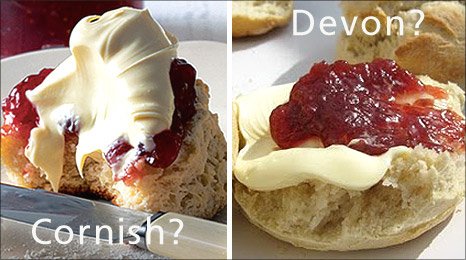
The innocuous looking scone has long been the subject of controversy and disputes about its origins, pronunciation and way of eating it.
Where did the scone originate?
Some claim it was created in the Netherlands, and its name derives from the Dutch word ‘schoonbrot’, meaning beautiful bread. Others are in no doubt that scones were first created in Scotland in the early years of the 16th century, whilst others insist they were conceived as a substitute for bread as long ago as the 14th century.
Is it ‘scone as in gone’? Or ‘scone as in stone’?
The scone divide – long ‘o’ versus short – has been well researched among those who study linguistics, and one pronunciation or the other is often attributed to the region of Britain one lives in. Those native to areas of the north of England and north Wales tend to rhyme scone with gone. South of this region either pronunciation seems to be acceptable, although around the edges of London, scone as in stone appears dominant. The Oxford English Dictionary is neutral, suggesting the word scone’s possible origins are in old Dutch or German.
However, it has been proven beyond any doubt that what we now refer to as scones started out in Scotland around 1505 as a speedily produced form of bread, baked on a griddle and often containing oats. The early years of the 16th century was a difficult time for Scotland as a result of the protracted 300-year war with England, finally ending in the tragic defeat of the Scots at the Battle of Flodden in 1513. Scotland found itself with a grave shortage of food, causing people to improvise and invent various kinds of quickly sustaining food to stave off hunger. As bread was cheap to make, and most importantly, a satisfying product that could fill the stomach and soothe the pangs of hunger, people soon adopted these baked rounds of dough made from flour, sugar and water as a bread substitute. Years later, these small doughy items were upgraded when people added milk and eggs to the ingredients, plus cubes of butter or any hard fat they could afford.
Devon or Cornwall?
The most common question among those gathered for a traditional cream tea is, ‘Are you a Devon or are you a Cornwall?’ referring to the order in which the cream/jam is spread on to the scone. A ‘Devon’ requires the clotted or whipped cream to be spread across the scone first, then topped with a blob of jam. Conversely, a ‘Cornwall’ means spreading a layer of jam first, and then plopping a small dollop of cream on top, which can then, if fancied, be lovingly smeared across the width and length of the scone. Some aficionados like to waver between the two by cutting their scone in half; on one half they will apply the Devon method, and on the other, the Cornwall way. That way, they can achieve the best of both worlds.
The temperature?
Equally divisive issues concerning the humble scone are whether to serve it at room temperature or gently warmed, and whether to bake the scone with integral raisins or sultanas, thus interrupting the smoothness of the eating experience. As to its accompanying jam or preserve, some would not entertain the idea of any flavour but strawberry, whereas others prefer a sharper fruit such as raspberry or blackcurrant to offset the sweetness of the scone and cream.
To slice or to pull?
There are those who insist that the scone should never be sliced in half with a knife, but instead gently pulled apart by hand into the two halves for spreading. I have seen this demonstrated at tea by a ‘pulling adherent’, but noted that it resulted in a rather crumbly mess on the plate, so the consistency of the baked scone really needs to be firm and spongey for this to be exercised successfully.
A scone burger?
Above all, it is just not right, after applying the jam and cream to the cut halves, to then re-form the whole scone back into a ‘scone burger’. This would require a large bite into it, and you will find yourself with a rather squidgy mess, either landing on the plate or on your clothes. Anyway, you can get much more jam and cream on each half separately than in the centre of a ’scone burger’!
World of Afternoon Tea would love to hear your thoughts on all the above. To wade in please do get in touch with [email protected]
